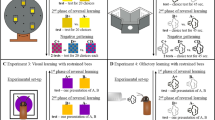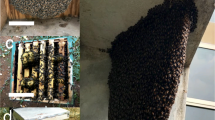Abstract
Ethologists have been interested for the most part in genetically based, species-typical behavior rather than in the effects of individual experience, and so was Kenneth Roeder, although he was deeply concerned with the variability of that behavior and the sources of variability. In one of his late papers (Roeder 1975), he discussed what he termed “evitability” in the evasive response of noctuid moths to the ultrasonic cries of hunting insectivorous bats, taking notice of the so-called Harvard law of animal behavior which states that, when experimental conditions are properly controlled, the animal will do just as it pleases. The paper nicely illustrates Roeder’s way of working: he would raise an interesting question on the basis of careful and critical observation of unconstrained behavior, formulate hypotheses about ecological and evolutionary determinants, and look for underlying neural mechanisms. The source of evitability in the evasive behavior of moths, Roeder suggested, might be found in some property such as trans-synaptic instability “downstream in the moth central nervous system.”
Access this chapter
Tax calculation will be finalised at checkout
Purchases are for personal use only
Preview
Unable to display preview. Download preview PDF.
Similar content being viewed by others
References
Bitterman ME (1975) The comparative analysis of learning. Science 188: 699–709
Bogdany FJ (1978) Linking of learning signals in honeybee orientation. Behav Ecol Sociobiol 3: 323–336
Couvillon PA, Bitterman ME (1980) Some phenomena of associative learning in honeybees. J Comp Physiol Psychol 94: 878–885
Couvillon PA, Bitterman ME (1982) Compound conditioning in honeybees. J Comp Physiol Psychol 96: 192–199
Erber J (1980) Neural correlates of non-associative and associative learning in the honey bee. Verh Dtsch Zool Ges, pp 250–261
Erber J, Masuhr T, Menzel R (1980) Localization of short-term memory in the brain of the bee, Apis mellifera. Physiol Entomol 5: 343–358
Frings H (1944) The loci of olfactory end-organs in the honeybee, Apis mellifera L. J Exp Zool 97: 123–134
Frisch K von (1921) Über den Sitz des Geruchsinnes bei Insekten. Zool Jb Physiol 38: 1–68
Grossmann KE (1970) Erlernen von Farbreizen an der Futterquelle durch Honigbienen während des Anflugs und während des Saugens. Z Tierpsychol 27: 553–562
Hull CL (1943) Principles of behavior. Appleton-Century-Crofts, New York
Koltermann R (1969) Lern-und Vergessensprozesse bei der Honigbiene aufgezeigt anhand von Duftdressuren. Z Vergl Physiol 63: 310–334
Kriston I (1971) Zum Problem des Lernverhaltens von Apis mellifica L. gegenüber verschiedenen Duftstoffen. Z Vergl Physiol 74: 169–189
Kuwabara M (1957) Bildung des bedingten Reflexes von Pavlovs Typus bei der Honigbiene, Apis mellifica. Hokkaido Univ Zool J Fac Sci 13: 458–464
Mackintosh NJ (1974) The psychology of animal learning. Academic Press, London
Menzel R (1967) Das Erlernen von Spektralfarben durch die Honigbiene. Z Vergl Physiol 56: 22–62
Menzel R (1968) Das Gedächtnis der Honigbiene für Spektralfarben. I. Kurzzeitiges und langzeitiges Behalten. Z Vergl Physiol 60: 82–102
Menzel R, Erber J, Masuhr T (1974) Learning and memory in the honeybee. In: Barton-Browne L (ed) Experimental analysis of insect behavior. Springer, Berlin Heidelberg New York, pp 195–217
Mercer AR, Menzel R (1982) The effects of biogenic amines on conditioned and unconditioned responses to olfactory stimuli in the honeybee Apis mellifera. J Comp Physiol 145: 363–368
Opfmger E (1931) Über die Orientierung der Biene an der Futterquelle. Z Vergl Physiol 15: 431–487
Pavlov IP (1927) Conditioned reflexes. Oxford Univ Press, Oxford
Roeder KD (1975) Neural factors and evitability in insect behavior. J Exp Zool 194: 75–88
Sheffield FD (1965) The relation between classical conditioning and instrumental learning. In: Prokasy WF (ed) Classical conditioning: a symposium. Appleton-Century-Crofts, New York Skinner BF (1948) ‘Superstition’ in the pigeon. J Exp Psychol 38: 168–172
Takeda K (1961) Classical conditioned responses in the honey bee. J Insect Physiol 6: 168–179
Thorndike EL (1911) Animal intelligence. Macmillan, New York
Vareschi E (1971) Duftunterscheidung bei den Honigbienen — Einzelzellableitungen und Verhaltensreaktionen. Z Vergl Physiol 75: 143–173
Author information
Authors and Affiliations
Editor information
Editors and Affiliations
Rights and permissions
Copyright information
© 1983 Springer-Verlag Berlin Heidelberg
About this paper
Cite this paper
Menzel, R., Bitterman, M.E. (1983). Learning by Honeybees in an Unnatural Situation. In: Huber, F., Markl, H. (eds) Neuroethology and Behavioral Physiology. Springer, Berlin, Heidelberg. https://doi.org/10.1007/978-3-642-69271-0_15
Download citation
DOI: https://doi.org/10.1007/978-3-642-69271-0_15
Publisher Name: Springer, Berlin, Heidelberg
Print ISBN: 978-3-642-69273-4
Online ISBN: 978-3-642-69271-0
eBook Packages: Springer Book Archive




